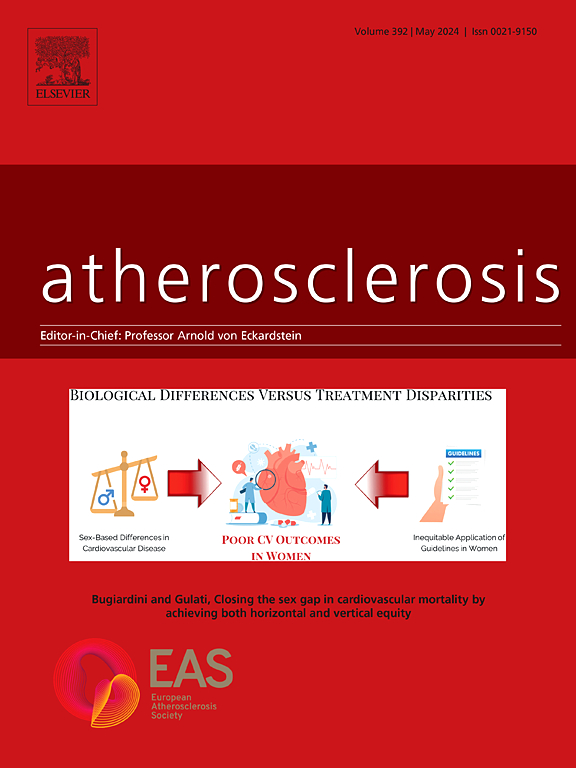Experimental evidence on colchicine's mode of action in human carotid artery plaques
IF 4.9
2区 医学
Q1 CARDIAC & CARDIOVASCULAR SYSTEMS
引用次数: 0
Abstract
Background and aims
Atherosclerosis, driven by inflammation, is a leading cause of cardiovascular events. Recent clinical trials have highlighted the therapeutic potential of anti-inflammatory treatments. Consequently, colchicine is being recommended for secondary prevention in current guidelines, although the drug's mechanistic actions are not fully understood.
Methods
To this end, we conducted a multiomic investigation of colchicine's effect on human carotid plaques. Sections from endarterectomy specimens were exposed to colchicine at concentrations of 2 ng/ml and 10 ng/ml ex vivo for 24 h and compared to untreated segments of the same plaque. Gene expression changes were analyzed by bulk RNA sequencing, and plaque secretomes underwent mass spectrometry for proteomic analysis. In situ cell proliferation was assessed by histology.
Results
Our data indicate, that colchicine suppresses neutrophil and platelet degranulation and activation, collagen degradation and atheromatous plaque macrophage proliferation in a dose-dependent manner in human plaques, while stimulating myofibroblast activation. Unexpectedly, interleukine (IL)-1beta release from colchicine treated plaques was not reduced. These results indicate that the inflammasome may not be the predominant target of low-dose colchicine in human carotid artery plaques.
Conclusion
Our study identifies multifactorial pathways through which colchicine, the first cardiovascular guideline-recommended anti-inflammatory drug, predominantly acts on human atherosclerotic lesions beyond the inflammasome. Targeting neutrophil and platelet degranulation, collagen degradation and macrophage proliferation, selectively, may provide substantial therapeutic benefit in atherosclerotic cardiovascular disease without colchicine's undesired side effects.

秋水仙碱对人颈动脉斑块作用方式的实验证据
背景和目的由炎症引起的动脉粥样硬化是心血管事件的主要原因。最近的临床试验强调了抗炎治疗的治疗潜力。因此,虽然秋水仙碱的作用机制还不完全清楚,但在目前的指南中,秋水仙碱被推荐用于二级预防。为此,我们对秋水仙碱对人颈动脉斑块的影响进行了多组研究。将动脉内膜切除术标本的切片暴露于浓度为2 ng/ml和10 ng/ml的秋水仙碱中24小时,并与未处理的同一斑块片段进行比较。通过大量RNA测序分析基因表达变化,并通过质谱分析斑块分泌组进行蛋白质组学分析。组织学观察原位细胞增殖情况。结果我们的数据表明,秋水仙碱以剂量依赖的方式抑制人斑块中中性粒细胞和血小板的脱颗粒和活化、胶原降解和动脉粥样硬化斑块巨噬细胞的增殖,同时刺激肌成纤维细胞的活化。出乎意料的是,秋水仙碱治疗斑块的白介素(IL)-1 β释放并未减少。这些结果表明,炎症小体可能不是低剂量秋水仙碱在人颈动脉斑块中的主要靶点。结论:我们的研究确定了秋水仙碱(第一种心血管指南推荐的抗炎药物)主要作用于炎性体以外的人类动脉粥样硬化病变的多因素途径。选择性地靶向中性粒细胞和血小板脱颗粒、胶原降解和巨噬细胞增殖,可能在没有秋水仙碱不良副作用的情况下,为动脉粥样硬化性心血管疾病提供实质性的治疗益处。
本文章由计算机程序翻译,如有差异,请以英文原文为准。
求助全文
约1分钟内获得全文
求助全文
来源期刊

Atherosclerosis
医学-外周血管病
CiteScore
9.80
自引率
3.80%
发文量
1269
审稿时长
36 days
期刊介绍:
Atherosclerosis has an open access mirror journal Atherosclerosis: X, sharing the same aims and scope, editorial team, submission system and rigorous peer review.
Atherosclerosis brings together, from all sources, papers concerned with investigation on atherosclerosis, its risk factors and clinical manifestations. Atherosclerosis covers basic and translational, clinical and population research approaches to arterial and vascular biology and disease, as well as their risk factors including: disturbances of lipid and lipoprotein metabolism, diabetes and hypertension, thrombosis, and inflammation. The Editors are interested in original or review papers dealing with the pathogenesis, environmental, genetic and epigenetic basis, diagnosis or treatment of atherosclerosis and related diseases as well as their risk factors.
 求助内容:
求助内容: 应助结果提醒方式:
应助结果提醒方式:


